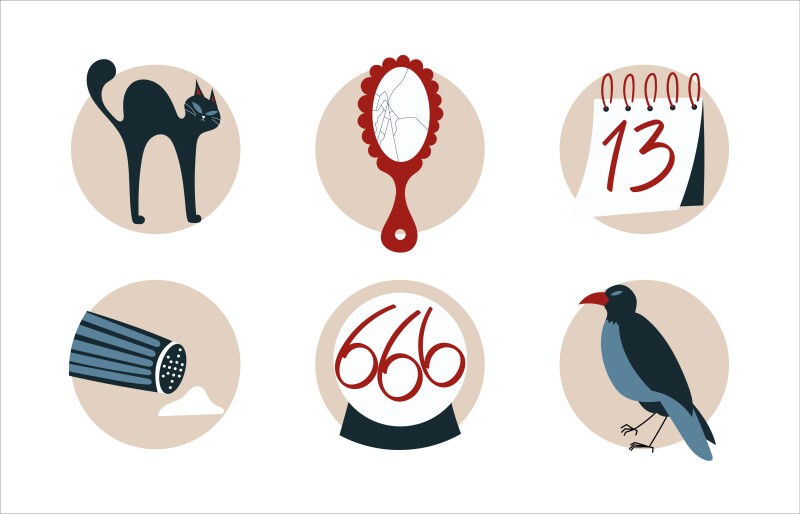Lifestyle
Unearthing the Origins of Superstitions: Black Cats to Broken Mirrors

Superstitions have long captivated human imagination, with beliefs surrounding black cats, Friday the 13th, and broken mirrors permeating cultures worldwide. These associations often stem from ancient myths, religious narratives, and societal fears that have evolved over centuries. Understanding the origins of these superstitions reveals insights into human psychology and cultural development.
Black Cats: From Demons to Deities
The belief that black cats bring bad luck has its roots in European history, particularly during the Middle Ages. During this period, cats became entangled with witchcraft, and black cats were viewed as demonic companions to witches. A papal decree issued by Pope Gregory IX in 1233 intensified this association, linking black cats to heretical rituals and fuelling public fear. This superstition was further propagated during witch hunts, ultimately making its way to the Americas with early settlers.
Contrastingly, not all cultures share this negative view of black cats. In ancient Egypt, they were venerated and associated with the goddess Bastet, symbolizing protection and fertility. Japanese folklore presents a different narrative, viewing a black cat crossing a woman’s path as an omen of good fortune in finding a partner. Likewise, sailors historically believed that having a black cat on board would ensure a safe journey.
Friday the 13th: A Day of Misfortune
The superstition surrounding Friday the 13th finds its origins in a blend of religious and historical contexts. In Christian tradition, the Last Supper featured thirteen attendees, with Judas Iscariot being the 13th guest who betrayed Jesus. The crucifixion of Jesus, which occurred on a Friday, has further solidified this date as unlucky. According to the Library of Congress, some historians suggest that the Christian Church sought to discredit Friday, named after the goddess Frigg or Freya, to undermine pagan practices.
The historical event of October 13, 1307, when King Philip IV of France ordered the mass arrest and execution of the Knights Templar, also contributes to this superstition. Additionally, in Norse mythology, the mischief of the god Loki, who was the uninvited 13th guest at a banquet leading to the death of Balder, reinforces the negative perception of the number 13.
Broken Mirrors: Reflections of the Soul
The belief that breaking a mirror brings seven years of bad luck traces back to ancient Roman traditions. Romans held that mirrors reflected the soul, and damaging one could harm the spirit itself. According to the University of South Carolina, they believed it took seven years for the soul to regenerate, thus linking broken mirrors to a prolonged period of misfortune.
Over time, this superstition has evolved with various remedies proposed to negate the bad luck associated with breaking a mirror. Common practices include grinding the shards into dust, burying the pieces, or tossing them into flowing water.
Two Mirrors: Portals to the Unknown
One of the more eerie superstitions involves the phenomenon of two mirrors facing each other, which some cultures believe creates a “ghost portal.” This idea stems from the infinite reflections that occur between the mirrors, potentially trapping spirits or allowing negative energy to flow between dimensions. Some variations suggest that this configuration can serve as a doorway for malevolent entities, complicating the natural flow of energy in a space.
As these beliefs illustrate, superstitions are deeply rooted in human history and culture, often reflecting societal fears and historical events. While some may dismiss these notions as mere folklore, they continue to influence behaviors and perceptions around the world.
Whether one subscribes to these superstitions or not, they offer a fascinating glimpse into the collective human psyche and the stories that shape our understanding of luck, fate, and the unknown.
-

 Science2 weeks ago
Science2 weeks agoIROS 2025 to Showcase Cutting-Edge Robotics Innovations in China
-

 Politics2 weeks ago
Politics2 weeks agoJudge Considers Dismissal of Chelsea Housing Case Citing AI Flaws
-

 World2 weeks ago
World2 weeks agoBravo Company Veterans Honored with Bronze Medals After 56 Years
-

 Top Stories2 weeks ago
Top Stories2 weeks agoIndonesia Suspends 27,000 Bank Accounts in Online Gambling Crackdown
-

 Lifestyle2 weeks ago
Lifestyle2 weeks agoStone Island’s Logo Worn by Extremists Sparks Brand Dilemma
-

 Health2 weeks ago
Health2 weeks agoStartup Liberate Bio Secures $31 Million for Next-Gen Therapies
-

 Sports2 weeks ago
Sports2 weeks agoMel Kiper Jr. Reveals Top 25 Prospects for 2026 NFL Draft
-

 Health2 weeks ago
Health2 weeks agoTop Hyaluronic Acid Serums for Radiant Skin in 2025
-

 World2 weeks ago
World2 weeks agoHoneywell Predicts Record Demand for Business Jets Over Next Decade
-

 Politics2 weeks ago
Politics2 weeks agoNew Jersey Voters Urged to Register Ahead of November Election
-

 Lifestyle2 weeks ago
Lifestyle2 weeks agoMary Morgan Jackson Crowned Little Miss National Peanut Festival 2025
-

 Sports2 weeks ago
Sports2 weeks agoYamamoto’s Mastery Leads Dodgers to 5-1 Victory in NLCS Game 2









